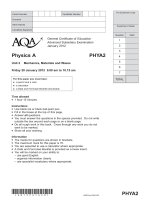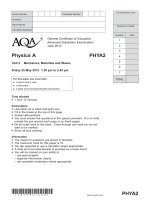AQA ANTH1 QP JUN15
Bạn đang xem bản rút gọn của tài liệu. Xem và tải ngay bản đầy đủ của tài liệu tại đây (141.25 KB, 4 trang )
General Certificate of Education
Advanced Subsidiary Examination
June 2015
Anthropology
Unit 1
ANTH1
Being Human: Unity and Diversity
Thursday 14 May 2015
9.00 am to 10.30 am
For this paper you must have:
l an AQA 12-page answer book.
Time allowed
l 1 hour 30 minutes
A
Instructions
l Use black ink or black ball-point pen.
l Write the information required on the front of your answer book. The Paper Reference is ANTH1.
lAnswer all questions.
l Do all rough work in your answer book. Cross through any work you do not want to be marked.
Information
l The marks for questions are shown in brackets.
l The maximum mark for this paper is 70.
l Questions carrying 10 marks or more should be answered in continuous prose. In these questions
you will be marked on your ability to:
– use good English
– organise information clearly
– use specialist vocabulary where appropriate.
H/JW/109322/Jun15/E3
ANTH1
2
Answer all questions.
Total: 70 marks
Read Items A and B below and answer all the questions that follow.
Item A
One distinctive characteristic of human beings is that they classify. Classification is an
important part of the way in which humans organise and make sense of their society and
the world around them. One example of classification is the division of things into ‘clean’
and ‘unclean’.
Douglas (1966) examined the Book of Leviticus in the Bible in order to show how some
foods are considered unclean and cannot be eaten. This is an example of a social norm
and is an important part of any society.
Item B
The study of the Na by Cai Hua, ‘Without Husbands or Fathers’ (2001), suggests that
males and females in this society do not get married and form a family. Instead, the man
will visit the woman in the house where she lives with her mother and her relatives. This
‘visit’ may be secret at first and then later more open. The couple never move into the
same house together. Though the man may spend a lot of time with the woman, he does
not live with her. If a child is born to the couple, it remains with the woman and her family.
H/Jun15/ANTH1
5
3
0
1
0
2
0
3
0
4
0
5
0
6
Explain what is meant by a ‘social norm’ (Item A, line 6) and illustrate your explanation
with an example, apart from that mentioned in Item A.
[4 marks]
Identify and briefly explain two effects of the natural environment on the culture of
social groups.
[6 marks]
Examine two or more ways in which the human body has adapted to the environment.
[10 marks]
Analyse two or more explanations for the origin of language in humans.
Examine the role of classification in human culture (Item A).
[20 marks]
‘Kinship is really the same in all societies.’
Using material from Item B and elsewhere, assess this view.
END OF QUESTIONS
H/Jun15/ANTH1
[10 marks]
[20 marks]
4
There are no questions printed on this page
Copyright © 2015 AQA and its licensors. All rights reserved.
H/Jun15/ANTH1









